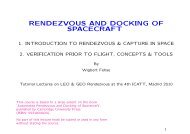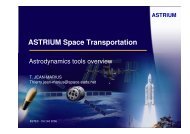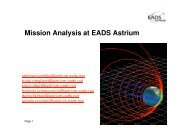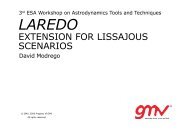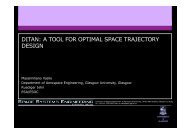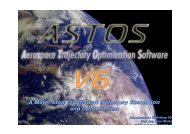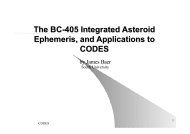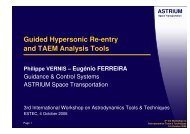Scilab use in the astrodynamics domain
Scilab use in the astrodynamics domain
Scilab use in the astrodynamics domain
You also want an ePaper? Increase the reach of your titles
YUMPU automatically turns print PDFs into web optimized ePapers that Google loves.
A software produced by The <strong>Scilab</strong> Consortium<br />
<strong>Scilab</strong> at a glance<br />
Example of implementation at CNES<br />
Didier Halgand<br />
<strong>Scilab</strong> Consortium / INRIA<br />
didier.halgand@<strong>in</strong>ria.fr<br />
ESTEC – October 4, 2006
Agenda<br />
• <strong>Scilab</strong> Position<strong>in</strong>g and Quick Product Description<br />
• The <strong>Scilab</strong> Consortium<br />
• International Presence<br />
• 2 Major Int’l outcomes<br />
• Example of <strong>Scilab</strong> Implementation at CNES<br />
(Presentation courtesy of Franck Re<strong>in</strong>qu<strong>in</strong> & Audrey Jambois – CNES)<br />
• Conclusion
<strong>Scilab</strong> Position<strong>in</strong>g<br />
and<br />
Quick Product Description
<strong>Scilab</strong><br />
The open source platform for numerical computation<br />
Numerical Computation<br />
software<br />
• A grow<strong>in</strong>g demand,<br />
• Used <strong>in</strong> research, simulation, control<br />
and embedded software generation<br />
processes,<br />
• Key success factors for <strong>the</strong><br />
development & control of <strong>the</strong><br />
technologies of <strong>the</strong> future,<br />
• In limited number on <strong>the</strong> market.<br />
<strong>Scilab</strong><br />
• Broad spectrum Open Source numerical<br />
computation software,<br />
• Cost effective tool <strong>in</strong>tegrat<strong>in</strong>g latest scientific<br />
contributions,<br />
• Produced by a Consortium hosted by INRIA,<br />
• Close to 20,000 remote load<strong>in</strong>gs<br />
each month,<br />
• Yearly Growth 20% !,<br />
• A comprehensive personal calculation platform,<br />
• A powerful Numerical Calculation Eng<strong>in</strong>e easy to<br />
embed <strong>in</strong>to applications,<br />
• A foundation for dedicated toolboxes.
<strong>Scilab</strong> Environment<br />
Runs under:<br />
• W<strong>in</strong>dows 9X/2000/XP<br />
• GNU/L<strong>in</strong>ux (PC, Mac Os X)<br />
• Most UNIX/X W<strong>in</strong>dow workstations<br />
Large number of toolboxes:<br />
• 2-D and 3-D graphics, animation,<br />
• L<strong>in</strong>ear algebra, sparse matrices,<br />
• Polynomials and rational functions,<br />
• Interpolation, approximation,<br />
• Simulation: explicit and implicit systems of differential,<br />
equations solution,<br />
• Scicos: block diagram modeler/simulator,<br />
• Classic and robust control, LMI optimization,<br />
• Differentiable and non-differentiable optimization,<br />
• Signal process<strong>in</strong>g,<br />
• Graphs and networks,<br />
• Parallel <strong>Scilab</strong>,<br />
• Statistics,<br />
• Interfaces with Computer Algebra (Maple),<br />
• Interfaces with Fortran, LabVIEW, Tcl/Tk, C, C ++ , Java.
Scicos<br />
Hybrid<br />
Dynamic<br />
Systems<br />
A <strong>use</strong>r-friendly GUI-based<br />
editor for model<strong>in</strong>g<br />
dynamical systems as block<br />
diagrams.<br />
Scicos is provided with <strong>Scilab</strong>
Scicos Functionalities<br />
• Hierarchical block diagram structure (super blocks),<br />
• A large number of standard blocks available <strong>in</strong> various palettes,<br />
• Possibility of def<strong>in</strong><strong>in</strong>g new blocks us<strong>in</strong>g C, Fortran or <strong>Scilab</strong> language,<br />
• Powerful formalism for model<strong>in</strong>g:<br />
• Hybrid systems<br />
• Implicit systems<br />
• Non causal systems us<strong>in</strong>g Modelica<br />
• Diagram compilation and fast simulation,<br />
• C code generation.
<strong>Scilab</strong> Major Application Fields<br />
• Any activity which implies <strong>the</strong> <strong>use</strong> of algorithms<br />
and/or simulation and control.<br />
• To date, major achievements <strong>in</strong>:<br />
• Automotive<br />
• Aviation & Space<br />
• Energy<br />
• Research
Ma<strong>in</strong> features:<br />
Current release: <strong>Scilab</strong> 4.0<br />
(February 15, 2006)<br />
• Improved W<strong>in</strong>dows version:<br />
• Complete <strong>in</strong>tegration, virtual memory<br />
• Compilers, performance (Atlas libraries)<br />
• Object oriented graphics:<br />
• Enhanced graphics functions (Matlab 1 syntax)<br />
• Powerful Graphics Editor<br />
• Java <strong>in</strong>terface,<br />
• Import of Excel 2 files,<br />
• Improved Matlab 1 -> <strong>Scilab</strong> translator.<br />
1<br />
Matlab is a trademark of The Mathworks<br />
2<br />
Excel is a trademark of Microsoft
Next Major Release: <strong>Scilab</strong> 5<br />
(Autumn, 2007)<br />
• Easier to <strong>use</strong>,<br />
• Cover<strong>in</strong>g numerical computation needs from basic ones up<br />
to high performance comput<strong>in</strong>g requests,<br />
• Best performance numerical computation software <strong>in</strong><br />
selected strategic doma<strong>in</strong>s,<br />
• Easier to embed <strong>in</strong> applications and to <strong>in</strong>teroperate <strong>in</strong><br />
heterogeneous environments,<br />
• Modular,<br />
• Integrat<strong>in</strong>g powerful scientific and technical breakthroughs,<br />
• Based on <strong>in</strong>dustry-standard libraries and languages …
The <strong>Scilab</strong> Consortium
The <strong>Scilab</strong> Consortium<br />
Rational & Vision<br />
Created, by INRIA, <strong>in</strong> 2003<br />
to answer a widely recognized need<br />
for an Open Source<br />
Numerical Computation Tool<br />
of high quality.
<strong>Scilab</strong> Consortium Members<br />
23 Companies & Academics …<br />
ANAGRAM TECHNOLOGIES, APPEDGE,<br />
ARTENUM, ATMEL, AXS INGENIERIE,<br />
CRIL TECHNOLOGY, CEA, CENTRALE,<br />
CNES, DASSAULT-AVIATION, EADS,<br />
ECOLE POLYTECHNIQUE, EDF, ENPC,<br />
ESTEREL TECHNOLOGIES, IFP, INRIA,<br />
KLIPPEL, PSA, RENAULT, STYREL,<br />
THALES, TNI<br />
…Steadily grow<strong>in</strong>g memberships
<strong>Scilab</strong> Key Players<br />
Inria<br />
French National Institute for Research <strong>in</strong> Computer Science and Control<br />
• Consortium host<strong>in</strong>g,<br />
• Legal responsibility,<br />
• Ma<strong>in</strong> supplier <strong>in</strong> eng<strong>in</strong>eer<strong>in</strong>g breakthroughs,<br />
• Fund<strong>in</strong>g.<br />
The Consortium<br />
• Project general management,<br />
• <strong>Scilab</strong> roadmap decision-mak<strong>in</strong>g authority,<br />
• Fund<strong>in</strong>g.<br />
The Operational Team<br />
• Activity Management,<br />
• Product management,<br />
• Core development,<br />
• Quality assurance,<br />
• First level assistance,<br />
• Contributors community coord<strong>in</strong>ation,<br />
• Market<strong>in</strong>g and promotion.<br />
External Contributors<br />
• Specialized toolboxes.
International Presence
An Increas<strong>in</strong>g Market Interest<br />
<strong>Scilab</strong> 4.0:<br />
Announced February 15, 2006<br />
More than 120,000 downloads<br />
up to now<br />
More than 500,000 downloads<br />
s<strong>in</strong>ce March 2003<br />
www.scilab.org<br />
More than 800,000 dist<strong>in</strong>ct<br />
visitors s<strong>in</strong>ce June 2004<br />
Dist<strong>in</strong>ct visitors/day<br />
June 2004: ~750<br />
April 2006: ~2400
International Presence<br />
Europe<br />
• <strong>Scilab</strong> <strong>use</strong>d <strong>in</strong> <strong>the</strong> European <strong>in</strong>tegrated<br />
project hArtes: ATMEL Roma, THALES …<br />
• EADS<br />
France<br />
• Strong presence <strong>in</strong> eng<strong>in</strong>eer<strong>in</strong>g of complex<br />
systems: CEA, CNES, Dassault Aviation,<br />
EDF, IFP, PSA, Renault, Thales …<br />
• <strong>Scilab</strong> <strong>use</strong>d as <strong>the</strong> numerical calculation<br />
platform <strong>in</strong> RNTL projects OMD and SCOS,<br />
• Scicos <strong>use</strong>d <strong>in</strong> RNTL projects SIMPA and<br />
ECLIPSE.<br />
Japan<br />
• Collaboration with NII 1 .<br />
North America<br />
• Collaboration with National Instruments,<br />
• Involved <strong>in</strong> NMC 3 numerical calculation<br />
standard def<strong>in</strong>ition.<br />
MORE THAN 250,000<br />
INSTALLED SEATS<br />
WORLDWIDE<br />
Ch<strong>in</strong>a<br />
• Represented by LIAMA 2 s<strong>in</strong>ce 2001.<br />
1<br />
NII: National Institute of Informatics - Japan<br />
2<br />
LIAMA: S<strong>in</strong>o-French Laboratory <strong>in</strong> Computer Science,<br />
Automation and Applied Ma<strong>the</strong>matics<br />
3<br />
NMC: Numerical Ma<strong>the</strong>matics Consortium<br />
Not allocated
2 Major Int’l Outcomes
The hArtes Project<br />
Biggest European fund<strong>in</strong>g <strong>in</strong> Embedded Systems<br />
Develop a tool cha<strong>in</strong> that support<br />
automatic or semi-automatic design<br />
of complex heterogeneous<br />
embedded systems,<br />
Validate <strong>the</strong> tool cha<strong>in</strong> on a set of<br />
<strong>in</strong>novative applications <strong>in</strong> <strong>the</strong> audio<br />
and video field.<br />
• Applications:<br />
FAITAL, Fraunhofer, LIA, Thales,<br />
Thomson, UNIVPM.<br />
• Tools & Methodologies:<br />
Imperial College, INRIA <strong>Scilab</strong>,<br />
LEAFF, PoliMi, TU Delft.<br />
• Hardware:<br />
Atmel, Europe Technologies,<br />
UNIFE.<br />
• Integration & Proof of concept:<br />
Atmel, FAITAL, Fraunhofer,<br />
Thales, Thomson, UNIVPM.<br />
A European<br />
Project
<strong>Scilab</strong> and LabVIEW <br />
<strong>Scilab</strong> / LabVIEW<br />
gateway<br />
under development<br />
(Beta version announced <strong>in</strong> August 2006)<br />
LabVIEW is a trademark of National Instruments.
© CNES © CNES – Octobre – 2005/ILLus. 2005/illus. D. D. Ducros Ducros<br />
Interfac<strong>in</strong>g <strong>Scilab</strong> with CNES<br />
widely <strong>use</strong>d MSLIB 90 and MADONA libraries<br />
Presentation courtesy of<br />
Franck Re<strong>in</strong>qu<strong>in</strong><br />
& Audrey Jambois<br />
CNES
MSLIB 90 Overview<br />
• MSLIB 90 is a Fortran 90 library, part of CNES flight dynamics<br />
software repository,<br />
• Along with several o<strong>the</strong>r core libraries, it covers a large spectrum of<br />
flight dynamics aspects,<br />
• MSLIB 90 is <strong>the</strong> successor of first generation MSLIB 77 and takes<br />
advantage of its robustness ga<strong>in</strong>ed through years of operations,<br />
• The current version represents 25 000 l<strong>in</strong>es of Fortran for 152<br />
rout<strong>in</strong>es, grouped <strong>in</strong> <strong>the</strong>matic sections :<br />
- Orbit propagation<br />
- Maneuvers and orbital transfers<br />
- Basic coord<strong>in</strong>ate systems<br />
- Solar system ephemeredes<br />
- Orbital parameters and coord<strong>in</strong>ate system conversions<br />
- Miscellaneous ma<strong>the</strong>matical functions
MSLIB 90 Use<br />
• MSLIB 90 is widely <strong>use</strong>d at CNES <strong>in</strong> :<br />
- all ground segments : FDS (Flight Dynamics Centers), missionrelated<br />
process<strong>in</strong>g centers such as image process<strong>in</strong>g facilities,<br />
- all mission preparation and analysis tools.<br />
• Usually <strong>use</strong>d from Fortran 90, <strong>the</strong> library can also be called from C,<br />
• MSLIB90 is tested/<strong>use</strong>d on many UNIX flavors (Solaris, IRIX, L<strong>in</strong>ux,<br />
HP-UX, …) and on W<strong>in</strong>dows.<br />
Sources freely available at: http://logiciels.cnes.fr (LGPL-like license)
<strong>Scilab</strong> Implementation Project<br />
• More and more eng<strong>in</strong>eers at CNES <strong>use</strong> <strong>Scilab</strong> to perform studies,<br />
• They request to be able to <strong>use</strong> <strong>the</strong> valuable collection of exist<strong>in</strong>g<br />
Fortran 90 libraries, so as to build up a new application quickly and<br />
pa<strong>in</strong>lessly…<br />
• Some Fortran rout<strong>in</strong>es have been put toge<strong>the</strong>r <strong>in</strong> a lightweight <strong>Scilab</strong><br />
framework (called SpaceLab) to be <strong>use</strong>d for <strong>the</strong> ATV mission<br />
analysis,<br />
• First step is to <strong>in</strong>terface MSLIB 90 with <strong>Scilab</strong>, <strong>the</strong>n <strong>in</strong>tegrate <strong>the</strong><br />
library + its <strong>in</strong>terface <strong>in</strong>to <strong>the</strong> SpaceLab framework. Then proceed<br />
with o<strong>the</strong>r libraries.
The way it works<br />
- Illustrative example of a <strong>Scilab</strong> application which reads an<br />
orbit bullet<strong>in</strong> from a file and displays <strong>the</strong> trajectory on a map,<br />
- MSLIB 90 library is <strong>use</strong>d for computations, and a dedicated file access library<br />
(called MADONA) to read <strong>the</strong> data.<br />
#<br />
Orbit<br />
bullet<strong>in</strong><br />
bullet<strong>in</strong> = {<br />
frame = {<br />
#Type of frame<br />
rep = "Ecliptique moyen"<br />
#Time frame<br />
ech_date = "2000"<br />
#Body rotation speed<br />
vrot = "0.7292115373E-04" ~rad/s<br />
#Obliquity<br />
obli = "0.23439280159E+02" ~deg<br />
#Central Body : Earth<br />
corcen = "Terre"<br />
}<br />
…<br />
Read file<br />
us<strong>in</strong>g<br />
MADONA<br />
<strong>Scilab</strong>/MADONA<br />
<strong>in</strong>terface<br />
libMadona.a<br />
Compute<br />
us<strong>in</strong>g<br />
MSLIB<br />
<strong>Scilab</strong>/MSLIB 90<br />
<strong>in</strong>terface<br />
libMSLIB.so<br />
Draw
• The required <strong>in</strong>terface layer is<br />
automatically generated from<br />
<strong>the</strong> function signatures,<br />
• Easy to <strong>use</strong> :<br />
- LINK command : <strong>the</strong> library<br />
and its <strong>in</strong>terface are<br />
dynamically loaded,<br />
- CALL command : creates<br />
entry po<strong>in</strong>ts for each MSLIB<br />
90/MADONA function.<br />
Outcome<br />
• Numeric precision checked for each function : identical to orig<strong>in</strong>al call.<br />
• Role of <strong>the</strong> <strong>in</strong>terface layer :<br />
- maps each library rout<strong>in</strong>e to a <strong>Scilab</strong> command named after <strong>the</strong> library<br />
rout<strong>in</strong>e, with very close syntax (same argument names) : hides <strong>the</strong><br />
complexity of <strong>the</strong> CALL function,<br />
- The <strong>Scilab</strong> command arguments are vectors/matrices, <strong>the</strong> library rout<strong>in</strong>es<br />
are called <strong>in</strong> a loop <strong>in</strong>side <strong>the</strong> <strong>in</strong>terface function ! performances.
Side Features<br />
• In-l<strong>in</strong>e comment extraction : <strong>the</strong> onl<strong>in</strong>e help is automatically generated.<br />
(This feature is effective with <strong>the</strong> MADONA library ; some <strong>in</strong>formation are<br />
currently miss<strong>in</strong>g <strong>in</strong> <strong>the</strong> MSLIB 90 source code headers).
Project Status<br />
• Work<strong>in</strong>g prototype, not very far from a f<strong>in</strong>al version ; this version is<br />
made available <strong>in</strong>ternally,<br />
• Still, additional work is required, <strong>in</strong> order to tackle some po<strong>in</strong>ts<br />
orig<strong>in</strong>ally bypassed dur<strong>in</strong>g <strong>the</strong> prototype development :<br />
- <strong>the</strong> MSLIB 90 functions must currently be packed with <strong>the</strong> <strong>in</strong>terface<br />
rout<strong>in</strong>es and <strong>the</strong> FORTRAN system libraries as a s<strong>in</strong>gle shared library,<br />
- <strong>the</strong> FORTRAN optional arguments are currently considered mandatory<br />
(sort of),<br />
- MSLIB 90 functions <strong>use</strong> a few FORTRAN derived types (structures) ; <strong>the</strong>ir<br />
<strong>Scilab</strong> counterpart currently <strong>use</strong> only simple types (<strong>in</strong>teger, real, …)<br />
beca<strong>use</strong> of <strong>the</strong> CALL syntax,<br />
• Once <strong>the</strong> process completed with MSLIB 90 and MADONA, o<strong>the</strong>r<br />
libraries will follow.
Conclusion
For your Numerical Computation needs<br />
th<strong>in</strong>k <strong>Scilab</strong> !<br />
…and even better, jo<strong>in</strong> <strong>the</strong><br />
<strong>Scilab</strong> Consortium<br />
• To allow and re<strong>in</strong>force fur<strong>the</strong>r <strong>Scilab</strong> developments,<br />
• To <strong>in</strong>fluence <strong>the</strong> product roadmap accord<strong>in</strong>g to your needs,<br />
• To benefit from attractive members rights.
A software produced by The <strong>Scilab</strong> Consortium<br />
<strong>Scilab</strong> contacts:<br />
Web site: www.scilab.org<br />
Technical contact: scilab@<strong>in</strong>ria.fr<br />
Market<strong>in</strong>g contact: didier.halgand@<strong>in</strong>ria.fr



